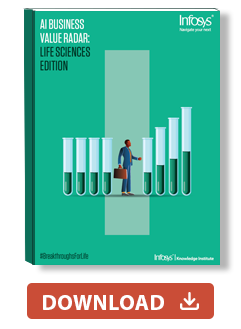Insights
- Life sciences companies excel at achieving business value from AI.
- High spending and digital transformation correlate with making use of AI.
- Enhanced workforce training and preparation for AI could lead to even stronger results.
- AI for drug development trails other use cases in terms of success rate.
Introduction
Life sciences companies are ahead of the pack in achieving value from artificial intelligence (AI), according to a new Infosys study. We surveyed 3,798 business leaders for the Infosys AI Business Value Radar and found that about 20% of AI use cases deliver on all business objectives, and 30% of use cases deliver on some objectives. (See Appendix A for methodology and more details on use cases studied.)
Focusing specifically on life sciences operations, we found that 28% of AI use cases deliver on all business objectives (vs. 19% across all industries) and an additional 37% (vs. 32%) have delivered on some objectives. Life sciences organizations have achieved more positive impact from AI, canceled fewer AI projects, and had fewer AI use cases in the sandbox (Figure 1). That’s better than practically all other industries.
Figure 1. Stage of use case deployments across the research sample
Life sciences companies have typically lagged in adopting new technologies. Extensive regulatory approvals for new software and processes limit how pharmaceutical organizations can try new tools. But the strictly regimented process-focused nature of their work matches well with what’s required to implement generative AI tools, such as having data that’s already clean and in a fit state to use with generative AI.
In contrast, the healthcare industry performed slightly below average in achieving value from AI. Healthcare organizations, of course, are in the business of healing and caring, but struggle with many competing definitions, standards, and stakeholders.
Life sciences and pharmaceutical organizations focus heavily on their core mission of drug discovery, and on product delivery and deployment. Their core business involves processing and analyzing proprietary data, over which they have strong controls and deep understanding. And regulatory requirements and safety standards require that drugmakers follow structured and detailed processes from testing to marketing to manufacturing.
“AI has been used in life sciences to accelerate established processes, maintain standards and comply with regulators,” says Subhro Mallik, Infosys executive vice president for life sciences. Mallik also believes drug discovery is an area where AI has much promise and can potentially deliver substantial benefit.
Standard technology infrastructure in life sciences organizations has enabled companies to quickly apply artificial intelligence. Infosys clients have applied AI and generative AI use cases across the value chain, particularly in Phase I to Phase III drug trials and in regulatory review.
Infosys and its clients are actively using AI to translate clinical trial information and to create plain-English summaries of clinical trial outcomes. Clients also are using AI to identify tumors in radiology scans, conduct biostatistical analysis, and draft regulatory documents.
Infosys subsidiary BASE life science has deployed a generative AI platform that uses AI agents that interface with legacy systems and enhance existing workflows ranging from clinical trials and regulatory processes to marketing and customer relationship management functions.
Where AI works
AI delivers value in life sciences for most industry-specific use cases as well as broad functional use. Figure 2 shows the top industry-specific use cases with higher “viability” — that is, that are most likely to generate business value.
Three life science-specific uses — AI for image and voice processing and diagnosis, AI for clinical trials, and AI for regulatory and submissions — ranked in the top 10 most viable uses of AI among 77 studied. A fourth life sciences use is AI for personalized and digital medicine scored 14th overall (Figure 2).
Figure 2. AI for life sciences scores very high
We also considered AI use cases in functional areas, that is, AI used for general business functions such as marketing, customer services, and human resources that are not necessarily tailored to an industry or specialization. In life sciences, respondents indicated that they use AI more in software development and IT operations than in other functional categories (Figure 3).
Figure 3. Top AI functional use cases in life sciences
Overall, life sciences organizations outpace other industries in successful AI use in functional areas of business (Figure 4, which shows the viability scores for the use case ranking in Figure 3).
Figure 4. Life sciences frequently achieve good outcomes across AI use categories, with one exception
But life sciences survey respondents said they do not frequently achieve business value on the most frequent functional use for AI: software development. Overall across all industries, AI for software development delivers positive outcomes, our survey found.
This is tied into the standardization and legacy nature of life sciences tech. With strict regulation and only a few vendors, many life science functions run on commercial, off-the-shelf systems, which limits the impact of AI on software development. While this limits the opportunity to create business value via software development, it means life sciences or pharmaceutical businesses can focus their tech budgets on business problems, says Infosys vice president Surya Duvvuri.
“They’re pouring all their energy into using technology to solve real business problems,” he adds.
Infosys has worked with a pharmaceutical client to build a platform for staffers to develop AI use cases. The platform, called Cortex, manages security and regulatory considerations, and links to select curated data sources. This creates a development environment that follows regulatory, explainable AI and responsible AI standards. With that in place, workers can choose AI models and large language models to develop AI use cases and integrate them with existing processes.
While our survey found that AI lags at delivering business value for software development in life sciences, Infosys leaders expect that to change. Gurdeep Singh Rooprai, an Infosys associate vice president, says he and client companies are developing effective ways to put AI to work with legacy systems and across the software development life cycle.
But in one critical area, the effort being put into getting AI to generate value is not bearing fruit. Using AI for drug discovery was the sole life sciences-specific use of AI scored by executives as not currently generating value. This is a core mission for pharmaceutical organizations, but also a complex task.
Big pharmaceutical businesses have invested heavily in using AI for drug discovery but have achieved limited success. One particularly enticing promise from AI is its ability to find new insights from large quantities of data.
Major pharmaceutical companies have decades of drug development and testing data in their archives. Most potential compounds don’t end up as safe and effective for the condition that they target. But imagine if AI systems could re-visit the test data and molecules with scaled up training models, Duvvuri says: AI could identify a new use for a therapeutic that failed to deliver on its intended use.
Infosys survey data and industry developments offer some hope that AI for drug discovery will become more viable.
First, our survey shows that AI for product development is going well in a broad sense. Next, rapid change and advances in AI s have potential to create new tools for drug discovery. This spring, researchers used AI to develop a new method for protein sequencing, which has application in health and life sciences. And newly developed LLM agents for biologic and medicine uses have potential to expand capabilities and build even more specific models for new therapeutics or new uses for therapeutics.
Life sciences and pharma businesses are pouring all their energy into using technology to solve real business problems.
Surya Duvvuri
Vice president, Infosys
AI requires transformation, investment
There is a very clear prerequisite to finding business value with AI. Successful life sciences use cases all require changes to operating models and data architecture to make them viable (Figure 5). This is true across all sectors: You have to do the transformation to unlock business value with AI.
Figure 5. 70% of the more successful use cases in life sciences require more tech and operational transformation
Tim Skeen, CIO at Sentara Health, said that his organization’s cloud-driven tech transformation is an advantage as it begins to apply AI to data and its operations. The Virginia-based healthcare organization has developed a data store for sharing clinical trial information and research supported by AI-driven data integrations. “Our operational systems that are generating data and usage, we have that connected to understand that across the spectrum,” he told Venky Ananth, Infosys vice president, in a video interviewT.
Our research finds a strong correlation between the amount spent on each use case and its relative viability. The more spent, the more successful a specific life sciences use case is likely to be. However, there are a number of opportunistic use cases, including image and voice processing and diagnosis that achieve high viability for relatively little spend (Figure 5). These are good bets for companies looking for lower cost AI wins.
Figure 6. Using AI for drug discovery has not frequently delivered business value, thus far at least
That said, with the falling costs of AI models, the calculus of AI viability may change in future. Use cases that did not score highly in our viability model, including drug discovery, could well start to become more viable as companies are able to invest more in them as the fundamental cost of doing AI falls. Further drug discovery is simply a more intricate task than automating a regulatory process. The more time, effort and expertise life sciences devote to it, the more we expect results to improve.
The workforce opportunity
Beyond tech transformation, our research finds that those whose organizations prepare their staff for AI perform even better in achieving business value from AI. Across all industries, the top tier of companies in workforce preparation achieves significantly better success with AI and business value.
To come to this finding, we asked respondents to select which definition in Figure 5 best matched their own company’s employee engagement with AI. We then categorized them into four archetypes (Figure 7).
Figure 7. Workforce readiness archetypes
Trailblazers, those who are fully engaged with AI, represent the top 16% of all respondents. About two-thirds of all companies fall into the middle two tiers (Explorers or Pathfinders) and the bottom tier of 17% we classify as Watchers (Figure 8).
Figure 8. Workforce readiness and AI
Given their capability to extract business value from AI, it would be easy to assume that life science companies do a strong job of preparing their workforce for AI and have a disproportionate share of Trailblazers.
That’s just not true. Most life sciences businesses fall into the middle two tiers and break out at roughly the same ratios as the whole survey. Infosys industry specialists say pharmaceutical businesses do well with AI because they already have strict processes and high-quality data.
Enhancing workforce readiness with AI is a tremendous opportunity for life sciences businesses. Life sciences organizations can improve their probability of success by 19 percentage points by advancing from the Pathfinder tier to Trailblazer, and a full 31 percentage points by moving from tier 3 Explorer status to Trailblazer.
Further, the 16% of life sciences businesses that have prepared their workforces to be Trailblazers have the highest levels of viability (Figure 9). Acceptance scores how easily customers or users adopted and accepted the outputs from a specific AI use case.
Figure 9. Workforce readiness enhances AI success
Making the most of AI is critical and timely for life sciences businesses, given scarcity and growing labor challenges in the sector. A 2024 report by Manpower Group found that life sciences has the greatest challenges with labor scarcity. And industry executives flagged replacing retiring employees as their top workforce challenge, according to a 2024 KPMG report.
“Pharma businesses are recruiting AI data scientists to their organizations, and pairing them with company veterans with business knowledge, and giving the business experts basic training in how artificial intelligence works,” Duvvuri says.
Bridging the gap between data science and drug discovery is where the work becomes difficult. Both the data scientist and business expert have deep expertise, but both also need to have better understanding of the other’s domain in order to generate value. The pharma experts receiving AI-driven insights are skeptical, Duvvuri says. “Are they telling me what I want to hear?”, he adds. “The translation from business to IT – how to look at the data and understanding different aspects — is where it is becoming difficult.”
Pharma businesses are recruiting AI data scientists to their organizations, and pairing them with company veterans with business knowledge, and giving the business experts basic training in how artificial intelligence works.
Surya Duvvuri
Vice president, Infosys
Spend, transform, train
AI suits the life sciences sector, and these companies lead the way in achieving value from it. But there remains more value to unlock.
The spend is worth it. Companies who invest in AI and in transforming their digital systems will have the advantage even in an industry with strong AI results. The cost and effort involved in transforming operating models and data architecture seems daunting, but the clear value that AI delivers is more compelling. From protein folding to mRNA vaccine innovations, AI has already demonstrated good value in life sciences.
Our research finds that putting AI to work and getting results can be costly in life sciences, but the return on investment is worth it. That ROI can be amplified through workforce engagement. Preparing workers for AI through training, education and positive change management leads to better acceptance and use of AI. And the more workers use AI to augment their efforts, the sharper their use cases will become.
AI agents — AI systems that can operate autonomously and across platforms — are being used by large pharmaceutical operations for a range of purposes, including drug discovery, personalized medicine, and management of regulatory processes. Our research found that deploying AI agents to orchestrate systems is a low-cost, low-effort and highly viable use of AI.
With the right transformation, workforce training, AI agents could unleash even greater business value from AI in life sciences. At this next frontier, business value could come even more readily.
Appendix A: Use case types used in the survey
Based on interviews with subject matter experts and desk research, we collated 55 use case types across 14 categories (Figure A1). We similarly collated 77 industry-specific use case types across 15 industry sectors (Figure A2). All these use case types are themselves at a level of abstraction higher than a specific use case, to make the survey manageable — but they are also relevant for all respondents.
Figure A1. Functional categories and their use case types
The survey asked respondents to select up to five functional categories out of 14 (Figure A1) where their companies are pursuing AI. Respondents provided details on these categories, the top five that their company is already interested in. As such, this is a self-selecting sample. In Figure 1, for example, we would typically expect far more projects that had failed, been canceled, or been in pilots for what is an early stage and experimental technology. Each category had between two and six common use case types (for example, product recommendation use cases in the sales and retail category). For each use case type within a category, respondents were asked about the stage of implementation of their initiative(s). Options for this question were: No plans to implement; Planning; Created proof of concept or pilot; Canceled before deployment; Deployed, not generating business value; Canceled after deployment; Deployed, generating some business value; Deployed, achieving most or all objectives. Respondents were then asked about the amount of spending for that use case type to date (from any start date). This was followed by questions about the amount of operational or business model change as well as the amount of change in data structures and technical architecture needed for each use case type.
Finally, respondents were asked about the proportion of their user base that accepted and used the AI tool deployed (if any) for each use case type. The same series of questions was asked of industry-specific use case types for the industry of the respondent (Figure A2).



















